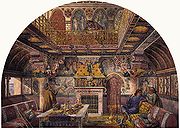Axel Haig
Axel Haig | |
|---|---|
 | |
| Born | Axel Herman Hägg 10 November 1835 |
| Died | 23 August 1921(aged 85) |
| Known for | Art (drawing, etching), architecture |
| Movement | Gothic Revival |
Axel Herman HaigRE(Swedish:Axel Herman Hägg;10 November 1835 –23 August 1921) was a Swedish-born artist, illustrator and architect. His paintings, illustrations and etchings, undertaken for himself and on behalf of many of the foremost architects of the Victorian period made him "thePiranesiof theGothic Revival."[1][2]
Life
[edit]Haig was born atKatthamrafarm in the parish ofÖstergarnon the island ofGotland.His parents were Axel Hägg, a landowner and timber merchant, and Anna Margaretha Lindström.[1]He was taught drawing and watercolor painting byPer Arvid Säve(1811–1887), who ran a private drawing school atVisby.[3]Haig was apprenticed as a shipbuilder at the government dockyard atKarlskrona.In 1856 he went toGlasgowfor a further period of training at a firm ofClydesideshipbuilders.[1]But his interests had turned to architecture and in 1859, he undertook a new apprenticeship as a draughtsman in the offices of theEcclesiastical Commissioners.[1]After seven years there, he launched himself as an architectural artist.
The middle years of the nineteenth century saw an explosion in the practice of architectural competitions. The wealth generated by the empire and theIndustrial Revolutioncreated the necessary conditions for a vast expansion in civic construction. Commissions for government offices, town halls, churches for private benefactors, railway termini were all put out to tender and competing architects required draughtsmen to illustrate their plans. In 1866 Haig met architect and designerWilliam Burges(1827–1881) when Burges retained him to illustrate his designs for theRoyal Courts of JusticeinThe Strand.[4]Haig produced a series of watercolour illustrations that were "an immediate sensation."[1]The competition's winner,George Edmund Street,is said to have remarked, "I wouldn't mind being beaten by drawings like those."[1]
In 1875, Haig made study trips toItalyandSicily,which resulted in a multitude of drawings and watercolors of mainly medieval architecture. Haig and Burges continued in partnership until the latter's death in 1881. In that time they produced some of the most spectacular medieval visions of the VictorianGothic Revival.Cardiff Castle,Knightshayes Court,theChurch of Christ the ConsoleratSkelton-on-Ure,St Mary's Church,Park House,theSpeech Room, Harrow School,Castell Coch,Trinity College, Hartford,Connecticutand the designs for the re-decoration ofSaint Paul's Cathedral:[5]as Burges designed his most important commissions, so Haig drew them. "In Haig, Burges, the architect of a medieval dreamland, had found an artist worthy of his dreams."[1]
Haig developed a second career as an etcher and his drawings and lithographs of European castles, palaces, landscapes and cathedrals became hugely popular in late-Victorian England. He was elected as a member of theRoyal Society of Painter-Etchers.[1]
Haig was mostly a resident of England, but spent the summers at the family farm on Gotland.Floda ChurchatSödermanland,Sweden, was rebuilt and underwent restoration between 1885 and 1888 on the basis of his drawings.[6]
Haig also designedAll Saints' Church, Grayswood,Surrey.It was built between 1901 and 1902 in a style described variously as SurreyVernacular[7]or "13th-century [Gothic] withArts and Craftselements ". Haig is buried in the graveyard. The church is a Grade IIlisted building.[8]
In a review of Haig's work published by theRoyal Institute of British Architectsin the year of his death, Maurice Adams wrote that "his architectural draughtsmanship ranks without a doubt amongst the foremost of his time and his graphic capability remains unique."[9]
Gallery
[edit]-
Floda Church in Södermanland
-
Haig's illustration for the Summer Smoking Room atCardiff Castle
-
All Saints Church designed by Haig in his adopted village of Grayswood
-
Haig's headstone
References
[edit]- ^abcdefghMordaunt Crook et al. 1984, p 13
- ^Jonas Gavel."Axel Herman Hägg".Svenskt biografiskt lexikon.Retrieved1 January2019.
- ^"Per Magnus Arvid Säve".Svenskt biografiskt handlexikon.Retrieved1 January2019.
- ^Axel Haig and the Victorian Vision of the Middle Ages page 16
- ^Axel Haig and the Victorian Vision of the Middle Ages page 17
- ^"Floda kyrka".christermalmberg.se.Retrieved1 January2019.
- ^Nairn & Pevsner 1971,p. 262.
- ^Historic England."Church of All Saints, Grayswood Road, Grayswood (Grade II) (1243910)".National Heritage List for England.Retrieved2 June2014.
- ^Journal of the Royal Institute of British Architects,Volume XXVIII (1921)
Sources
[edit]- Armstrong, E.A,Axel Herman Haig and His Works(1905)The Fine Art Society,Ltd
- Mordaunt Crook, J.and Lennox-Boyd, C,Axel Haig and the Victorian Vision of the Middle Ages(1984)George Allen and Unwin
- Nairn, Ian;Pevsner, Nikolaus(1971) [1962].The Buildings of England: Surrey(2nd ed.). Harmondsworth:Penguin Books.ISBN0-300-09675-5.




